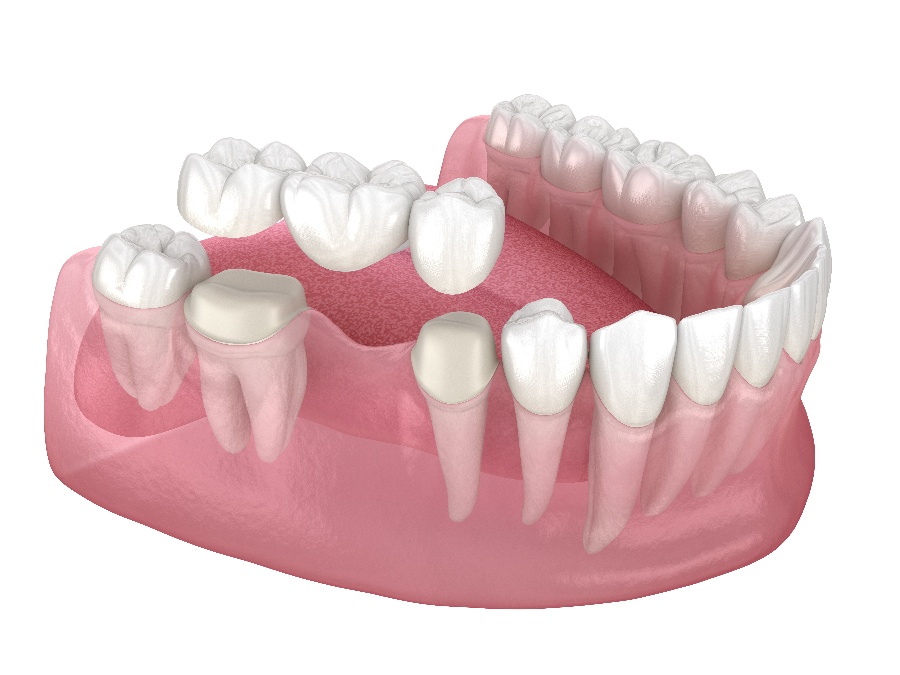About five percent of Americans are born with one or more missing teeth (excluding wisdom teeth), a condition known as hypodontia. The most common teeth missing can be visible when you smile—lower second bicuspids, maxillary lateral incisors, and second bicuspids.
Common causes of missing teeth include tooth decay, gum disease, cracked tooth, or trauma. Not only is it essential to replace missing teeth, but choosing the best treatment is important.
Three Reasons to Replace a Missing Tooth
A missing front tooth presents a cosmetic issue that does not usually require convincing to replace it. Some people hesitate to replace a missing tooth that “nobody ever sees.” However, aesthetics is only one of several reasons to replace missing teeth, such as:
- To preserve bone in your jaw.
- To prevent adjacent and opposite teeth from moving out of place.
- To enable chewing and speaking normally.
Dental implants and fixed bridges are two common ways to replace one or several missing teeth. Both have advantages and disadvantages to discuss with your dentist before deciding.
What is a Fixed Dental Bridge?
A fixed dental bridge is a dental bridge that replaces missing teeth. The most common dental bridges close a gap between two natural teeth. Dental cement attaches the appliance to adjacent teeth to make it immovable and different from a removable partial denture.
The three types of fixed dental bridges that rely on natural teeth for support are:
1. Traditional dental bridges are the most popular bridges and have been used in some form since ancient times. Modern bridges fuse an artificial tooth to crowns on both sides of a gap between natural teeth. The crowns are cemented in place as a single unit.
2. Cantilever bridges are the one type of bridge not supported on both sides by a natural tooth. The artificial tooth is attached to one or two teeth on one side and suspended over the gap, unsupported by a tooth behind the gap. These are rarely used due to complications from insufficient support.
3. Maryland bridges attach to adjacent teeth without removing tooth structure for crowns to support the artificial tooth. The replacement tooth (pontic) is bonded to a tooth on both sides using a metal mesh, or “wings.” Maryland bridges can only be used on select cases, typically to replace a front tooth, due to their lack of durability. When used properly, they can enjoy a high rate of success.
Advantages of a Fixed Bridge
Fixed dental bridges offer several benefits, including:
- No surgery is needed. Most fixed bridges require only preparing adjacent teeth for crowns, taking impressions of your mouth, fabricating a temporary bridge, and final placement of the permanent bridge. These are routine dental procedures done without surgery and sutures.
- The procedure is time efficient. A traditional fixed bridge does not require waiting for bone and gums to heal before proceeding with treatment. Typically, you need two office visits to complete treatment.
- The bridge provides a secure feeling. Fixed dental bridges do not move when eating or speaking. Since they are permanently attached and immovable, you can have the confidence to eat and speak normally.
- The bridge restores a natural appearance. The porcelain and ceramics used today can restore your natural appearance. You also maintain the support of your facial muscles that tend to sag if missing teeth are not restored in a timely way.
- Your bite is stabilized. Because a bridge is permanently attached to adjacent teeth and optimally bites against opposing teeth, your natural teeth do not move. This stability prevents problems that occur when teeth shift and your bite changes.
Disadvantages of a Fixed Bridge
As you consider how to replace a missing tooth, you may want to consider a few disadvantages. A fixed bridge:
- Requires removing tooth structure from teeth to support the bridge.
- Does not help preserve the bone you lose after an extraction.
- Requires that you use special devices, such as floss threaders, for oral hygiene.
- May require remaking if an adjacent supporting tooth gets tooth decay.
- Places more than usual stress on the supporting teeth.
What is a Dental Implant?
A dental implant is an artificial post or screw placed in the jaw bone to replace the roots of a missing tooth. Most dental implants are made of titanium that fuses to the bone after surgical placement to support a crown. Implants have become a popular treatment to replace a single missing tooth instead of a fixed dental bridge. Implants can also help support dentures and bridges that replace multiple teeth.
The word implant is often used to describe more than the screw or post placed in the bone. It can also refer to the entire prosthesis, including the screw and the attached crown.
Advantages of a Dental Implant
The advantages of dental implants include the following:
- High success rate. Studies have shown the success rate to be between 90%-95%. The improvements in technique and materials have significantly improved implants’ success rate and driven their popularity.
- Durability. With proper care, implants can last a lifetime. The dental crown portion can wear out and need replacing, but implants are placed with the intention of being permanent.
- Bone preservation. If there is not an extended period of time after tooth extraction, an implant prevents bone loss from the jaw. This occurs without stimulation from the tooth’s roots.
- Appearance. Implants improve appearance by helping to maintain the bony support of your facial muscles. Additionally, because implants provide a root to support a crown instead of artificially attaching it to adjacent teeth, it restores the natural contours of a tooth.
- Oral health. You can brush and floss normally with an implant. You will not need devices like floss threaders used to clean under and around the replacement tooth.
- Confidence. Implants restore the look and function of natural teeth so well that they offer tremendous emotional benefits such as more confidence and improved self-esteem.
Disadvantages of a Dental Implant
Although dental implants have no real disadvantages, there are a few reasons you may want to consider another option, such as:
- You have a medical condition that prevents you from having surgery.
- You have inadequate bone, and a bone graft is not possible.
- You have poor oral hygiene.
- You have periodontal disease.
- You smoke.
Schedule an Appointment
Dental implants have been known to change people’s lives. If you are missing one or all of your teeth, contact us online or call us to learn more about how Palmetto Dental Arts can restore your smile with implants using leading-edge technology and advanced dental techniques.







